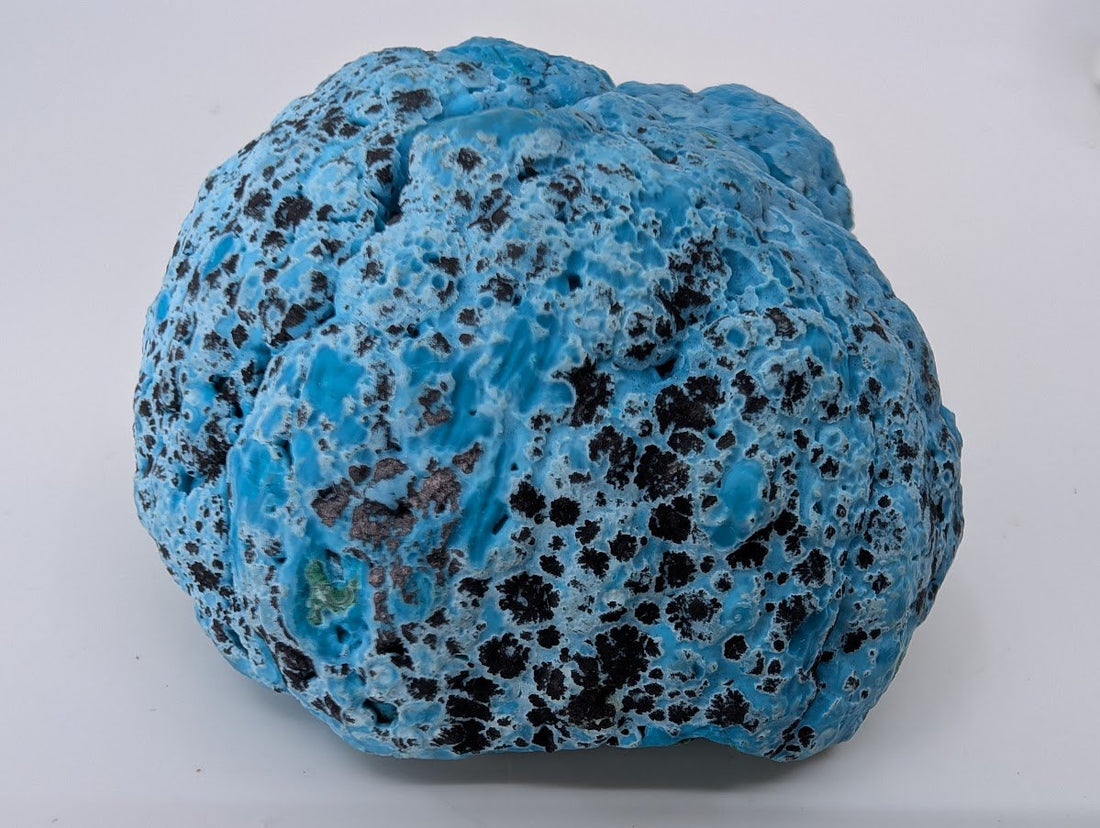
Chrysocolla with Malachite from the Congo: Nature’s Turquoise Treasure
Share
Chrysocolla with Malachite from the Congo: Nature’s Turquoise Treasure
If you're a lover of vivid color, bold mineral formations, or spiritually grounding stones, chrysocolla with malachite may be one of the most breathtaking mineral combinations you'll ever encounter. This unique copper-based blend, especially when sourced from the Democratic Republic of the Congo (DRC), produces some of the world’s most collectible and visually stunning specimens.
In this article, we’ll explore what chrysocolla and malachite are, how they form together, why the Congo produces such extraordinary examples, and what makes them so sought after by collectors and energy workers alike.

What Is Chrysocolla with Malachite?
Chrysocolla is a copper-based mineral that often forms in bright blue to green hues, resembling turquoise. It is a hydrated copper phyllosilicate and usually forms in the oxidized zones of copper ore bodies. Because it is relatively soft and often found in massive or botryoidal formations (rounded, bubbly surfaces), it’s most appreciated in its natural form or paired with other minerals.
Malachite is another copper carbonate hydroxide mineral, recognizable by its rich, deep green color and banded growth patterns. It often forms in stalactitic or botryoidal masses and is one of the oldest known copper minerals, used for thousands of years as pigment and ornamentation.
When these two minerals occur together, the result is a jaw-dropping contrast of electric blues and velvety greens, often with intricate internal banding, bubbles, and flowing textures. Together, they tell a story of geologic beauty and chemical harmony.
Where Does It Come From?
While chrysocolla and malachite can be found in copper-rich regions around the world — including Arizona (USA), Peru, and Namibia — some of the most dramatic and collectible specimens come from the Democratic Republic of the Congo, particularly in Haut-Katanga Province.
This region is part of the Central African Copperbelt, one of the richest sources of copper ore on Earth. Here, the perfect combination of copper-rich fluids, oxidized zones, and long geological timelines created ideal conditions for these minerals to form together.
In Congo specimens, you’ll often find:
- Intensely saturated blue chrysocolla with tight, botryoidal surfaces
- Thick malachite banding or veining exposed naturally or through slicing
- A raw, sculptural form that looks like living geology
How Chrysocolla and Malachite Form Together
Both chrysocolla and malachite are secondary copper minerals, meaning they form as the result of chemical changes to primary copper sulfide minerals like chalcopyrite or bornite.
When copper-rich water percolates through rock layers, it can precipitate different minerals depending on pH levels, temperature, and the presence of carbonates or silicates.
- Malachite often forms first, developing as banded crusts or masses.
- Chrysocolla can form later or in tandem, coating malachite or filling in crevices and voids, leading to the signature swirling, layered look.
The most spectacular specimens form when this process repeats in cycles, building concentric bands, intermixed colors, and botryoidal growths that create the bubbly, brain-like textures collectors love.
Why Collectors and Energy Workers Love It
💎 For Collectors:
- Rarity – Congo specimens are more limited than in the past due to reduced mining output and restricted access to high-quality material.
- Visual Impact – The intense colors, striking veining, and natural sculptural forms make these specimens centerpiece-worthy.
- Natural Growth Features – Botryoidal surfaces, malachite "eyes", and exposed banding make each piece one-of-a-kind.
🔮 For the Metaphysical Community:
- Chrysocolla is said to be a stone of communication, emotional expression, and inner peace. It's associated with the throat and heart chakras, helping users speak their truth and connect to higher wisdom.
- Malachite is considered a stone of protection and transformation. It’s used for absorbing negative energy, encouraging change, and offering emotional insight.
Together, they provide a powerful energetic combination — calming, protective, and empowering all at once.
Tips for Displaying and Caring for Your Chrysocolla-Malachite
Because both minerals are relatively soft (especially chrysocolla, which can rate as low as 2.5 on the Mohs scale), care should be taken to preserve their natural beauty:
- Avoid prolonged water exposure – Clean gently with a dry or slightly damp cloth.
- Display out of direct sunlight – This prevents fading and keeps the surface from drying.
- Use neutral stands – Clear acrylic or dark wood stands allow the color to take center stage.
- Lighting matters – Warm lighting will bring out the green malachite veins; daylight-tone lighting enhances the blues.
How to Identify Authentic Congo Chrysocolla with Malachite
With the rise of dyed materials and synthetic combinations, it’s important to know how to spot the real deal:
- ✅ Botryoidal texture – Congo specimens usually have bubbly, globular surfaces
- ✅ No polish or dye – Most premium specimens are completely natural
- ✅ Color zoning – Real pieces will show malachite as veins, eyes, or banded zones
- ✅ Heft & Density – Natural chrysocolla with malachite is surprisingly dense due to its high copper content. A 600g specimen may appear small in size but will feel noticeably heavy in the hand—this is a great sign of authenticity and mineral purity, especially in unaltered pieces from the Congo.
Always buy from trusted sources (like Legacy Crystals and Minerals) that can provide provenance and high-resolution images.
Final Thoughts: Why Congo Chrysocolla with Malachite Is a Must-Have
Whether you’re looking to deepen your mineral collection or bring high-vibration copper energy into your space, chrysocolla with malachite from the Congo offers natural elegance, geologic storytelling, and energetic richness in one beautiful package.
These specimens aren’t just rocks — they’re art, science, and spirit combined.



